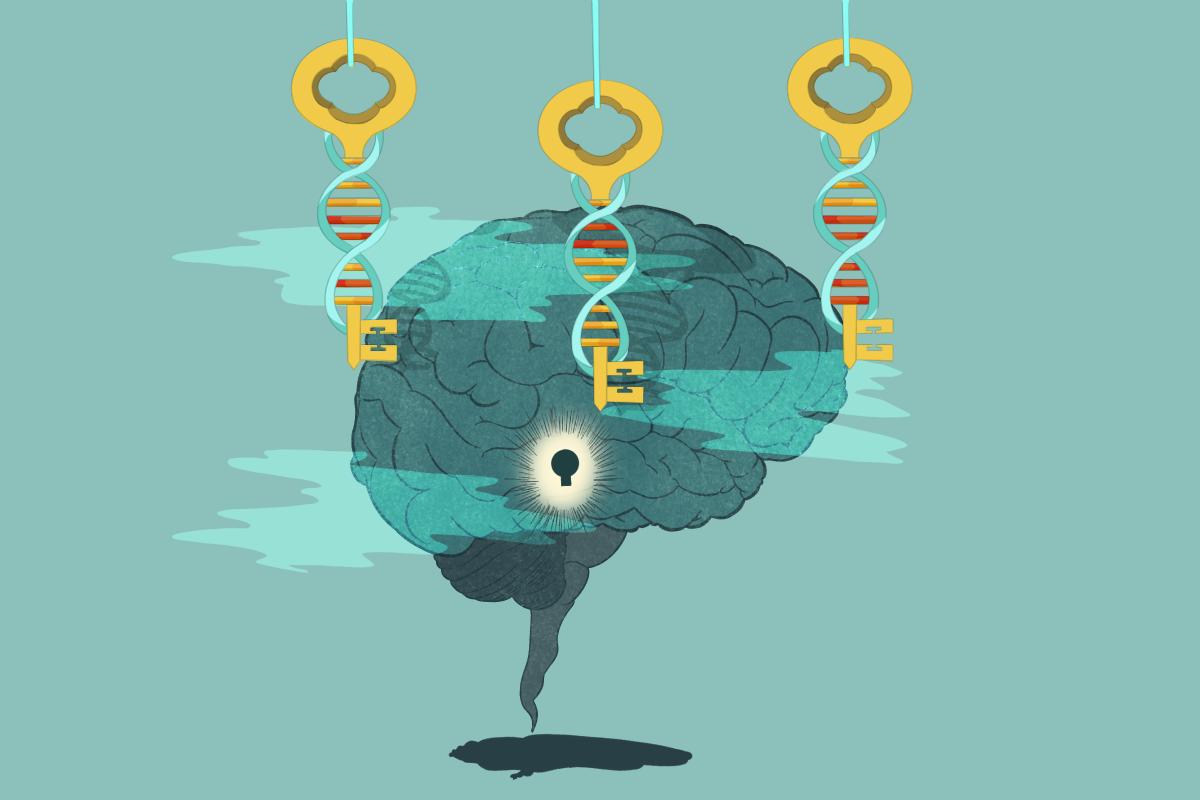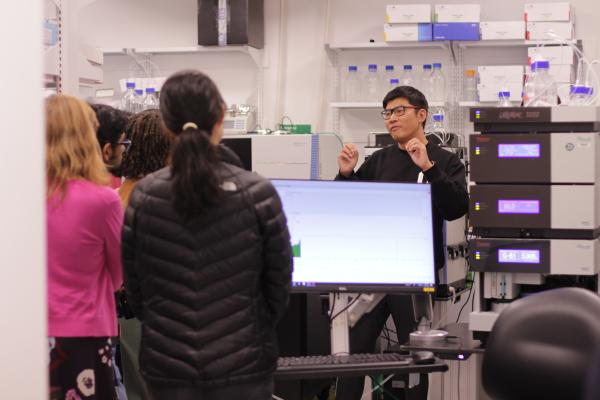CARD Stacks the Deck Against Alzheimer's
NIH's Center for Alzheimer’s and Related Dementias Explores Genetics, Biomarkers, and More
BY PAIGE JARREAU, NIA

CREDIT: NIA, CARD
Nearly ten million times a year—every three seconds worldwide—a new case of dementia is diagnosed. Often it is Alzheimer’s disease (AD), the most common form of dementia. In AD, proteins build up abnormally or aggregate to form amyloid plaques and tau tangles, which lead to the hallmark symptoms of impaired memory and thinking abilities.
Although for many, dementia is synonymous with AD, this family of neurological degenerative diseases also includes Lewy body dementia (LBD), frontotemporal dementia (FTD) with or without associated amyotrophic lateral sclerosis (ALS), and vascular dementia. LBD is associated with abnormal deposits of alpha-synuclein that are also involved in Parkinson’s disease (PD). FTD is strongly linked to ALS.
Growing evidence suggests all of these diseases share some biological pathways and genetic risk factors. While the exact mechanisms of their onset and progression remain unknown, we are getting closer to a profound understanding.
Nested within the NIH’s intramural research program is the NIA–NINDS Center for Alzheimer’s and Related Dementias (CARD), where researchers are working to identify the underpinnings of these diseases and approaches to early intervention and treatment. CARD Director Andrew Singleton, a distinguished investigator at NIA, leads the center with a mission to initiate, stimulate, accelerate, and support research in AD and AD-related dementias (AD/ADRD).
Dedicated in 2022 in honor of former Senator Roy Blunt (R-MO), CARD is housed in a dedicated 24,000 net square foot building (T44) on the NIH Bethesda campus, CARD comprises diverse scientists and collaborators from across and beyond several NIH institutes, centers, and offices. CARD staff work at the forefront of many areas including genome sequencing, functional genomics, lab automation, data science and data sharing, and open-source tool development. CARD’s early projects involved creating stem cell models of disease, such as the iPSC Neurodegenerative Disease Initiative (iNDI) project, using long-read DNA sequencing to identify novel disease-causing genetic variants, and developing strategies to clear protein aggregates from the brain. Since its launch, CARD also has used advanced data science and open science approaches to accelerate discoveries.
Today, CARD continues to advance these projects. The center has new projects, too, that involve searching for missing causal genetic variants in non-European populations, developing complex multicellular models of neurodegeneration, and identifying biomarkers, to name a few.
Searching for ancestrally diverse genetic causes and risk factors of dementia
Researchers have identified hundreds of regions of the genome associated with AD/ADRD. These regions, known as loci, often are identified in genome-wide association studies (GWAS). Yet mysteries remain about which specific variants in most of these loci are causal, or responsible for disease-related changes. With a specific variant identified, researchers must still determine its effect on gene regulation and cell biology in different populations.
One barrier to solving these mysteries is that most genomic studies of neurodegenerative disorders lack genetic diversity and thus leave out potential ancestry-specific genetic factors of disease (PMID: 37198259). This makes it more difficult to determine which genetic variants across all populations may be causal. CARD’s Expert Groups are working to address this issue.

CREDIT: CARD
Sara Bandrés-Ciga
“Much of the information we have on regions of the genome linked to AD/ADRD risk, age at onset, and progression comes from European populations. This fact limits our understanding of dementia,” said Sara Bandrés-Ciga, a staff scientist and leader of the Genetics Expert Group as well as Training and Outreach at CARD. “Including data from dementia cases and controls from different ancestral populations gives us more statistical power and resolution. We can narrow down causal genes and mechanisms by overlaying diverse haplotype structures. It also allows us to identify population-specific genetic factors linked to disease etiology.”
CARD has demonstrated the value of more diverse genetics research. In a study published in Nature Genetics, CARD scientists and collaborators curated ancestrally diverse PD data (PMID: 38155330). With these data, they identified 12 potentially novel loci associated with PD. They then chose the potential causal genetic variants within six of the loci using a process called fine-mapping. Fine-mapping identifies the specific mutation likely responsible for a locus association with disease.
In the largest multiancestry meta-analysis of previously published GWAS to date, CARD researchers identified two novel AD/ADRD loci and fine-mapped nine previously identified loci (PMID: 37198259). This study also provided further evidence that known risk factors for AD, including APOE4, have different effects across different ancestral populations.
CARD is working with the Multi-Partner Consortium to Expand Dementia Research in Latin America (ReDLat) to sequence data from people with and without AD and other dementias in Chile, Argentina, Brazil, Perú, Colombia, Mexico, and other countries.
“Collaborators send DNA samples that we help produce genetic sequencing data for,” Bandrés-Ciga said. “We then train our collaborators on how to analyze these data so that they can address their own scientific questions.”
Developing cellular models for dementia research
In addition to cultivating more diverse genetic data, CARD researchers are creating cellular models of neurodegeneration to study how specific genetic variants affect downstream processes. These models include genetically engineered stem cell lines and organoids.
CARD’s iNDI is a large genetic engineering project devoted to creating induced pluripotent stem cell (iPSC) lines for dementia research (PMID: 33831364). Each cell line carries a single genetic variant associated with AD/ADRD. Scientists can use any of these lines to investigate how a specific variant affects gene expression, biological pathways, and cell behavior. So far, the project has generated nearly 200 different iPSC lines used by more than 450 laboratories across 26 countries (PMID: 36459969).

CREDIT: CARD
Elise Marsan
Elise Marsan leads the new Molecular Pathology Unit at CARD. She and her group are excited to pursue a new step in the development of cell-based models for studying dementia. They plan to grow brain organoids, which are 3D models of iPSC-derived brain cells. These organoids closely mimic the multicellular complexity of the brain.
“We can look at the interplay and communication between different types of brain cells and how this is affected by dementia-related mutations,” Marsan said. She aims to leverage brain organoids to explore how changes to the TDP-43 protein contribute to dementia pathology in AD, FTD, and a recently discovered type of dementia called LATE, or limbic-predominant age-related TDP-43 encephalopathy.
“Traditional methods of studying dementia in the lab typically involve looking at postmortem brain tissue or cerebrospinal fluid,” said Phil Gross, a postdoctoral fellow in Marsan’s lab. “These samples come from people who are already pretty far into disease or already deceased. We want to use organoids to model the development of these diseases at earlier stages. Organoids have a lot of advantages. You get a lot of the complexity, different cell types, and cortical organization that you don’t get with other in vitro models.”
Additionally, CARD is working on ways to isolate and analyze other aspects of neurodegeneration in the lab, such as a project with NIDDK that aims to model the aging process in neurons.

CREDIT: CARD
Andy Qi
Improving early diagnosis and treatment
CARD scientists are also conducting large-scale studies on proteins to determine how genetic changes affect gene expression and to help find potential biomarkers. Andy Qi leads the Proteomics Expert Group at CARD. In collaboration with CARD's Advanced Analytics Expert Group, Qi’s group has created a fully automated pipeline for quickly analyzing proteins from many different samples (PMID: 38181731). The pipeline enables robust and reliable comparisons between samples, which helps accelerate the search for potential biomarker proteins present in disease but absent in control samples.
“Protein biomarkers have become the most common clinical markers in body fluids,” Qi said. “We are working to identify clinically relevant protein biomarkers for AD/ADRD.”

CREDIT: CARD
Andy Qi giving a tour of the proteomics equipment at CARD.
Qi’s group combines genetic and protein data from human tissue, blood, cerebrospinal fluid, and cultured cell samples. This comprehensive “proteogenomic” strategy helps the group identify observable changes in proteins caused by genetic variants associated with AD/ADRD.
“Our strategy is powerful for biomarker discovery and investigation of the fundamental biology of Alzheimer’s disease and related dementias,” Qi said. His group works with collaborators, including ReDLat and NINDS, to investigate promising biomarkers (PMID: 37168844).
In a project with NINDS, Qi’s group has found that abnormal proteins produced by RNA splicing errors can be detected in the cerebrospinal fluids of FTD and ALS patients (PMID: 38277467). An RNA splicing-regulator protein called TDP-43 causes these splicing errors.
“TDP-43 pathology is involved in both ALS and FTD,” said Colleen Bereda, a postbaccalaureate fellow working in CARD’s Proteomics Expert Group and at NINDS. The TDP-43 protein regulates RNA splicing. In disease it gets “mislocalized” within the cell. The protein then produces splicing errors that result in cryptic RNA transcripts, which result in other abnormal proteins.
“We’re hoping that some of these cryptics could be useful as biomarkers,” Bereda said. “The goal is to find RNA or proteins that are robustly present in disease and absent in healthy controls. Ideally, we can find these biomarkers via tests on blood or cerebrospinal fluid—even before people have symptoms.”
CARD’s Neurogenomics and Diagnostics Research Unit, led by senior scientist Kendall Van Keuren-Jensen, aims to further explore various RNAs and proteins as novel biomarkers. The unit will focus on improving AD/ADRD diagnosis and patient stratification. The latter is the process of placing patients into subgroups based on specific disease characteristics that might affect their prognosis and response to available treatments, for example.
The role of data science and open science
CARD employs a large team of data scientists who use the latest in analysis techniques and data science technologies, including machine learning, to study dementia. They also support the implementation of open science at CARD and work alongside lab scientists to create, process, and share the latest experimental tools and robust AD/ADRD datasets. These scientists additionally process and place datasets created at CARD into open repositories for the broader research community, and combine and leverage data from other open repositories and biobanks to help advance the field.
For example, in 2023, this research team analyzed existing medical records to show that exposure to some viruses may raise one’s risk of being diagnosed with a neurodegenerative disorder later in life (PMID: 36669485).

CREDIT: CARD
Mike Nalls
“Any protocols, datasets, and data-analysis approaches or pipelines we create for our projects, we also make openly accessible to the broader research community,” said Mike Nalls, who leads CARD’s Advanced Analytics Expert Group. The group also creates custom knowledge-sharing and data-browsing tools that make big and complex datasets more accessible.
In January 2024, Nalls and colleagues published an article in Nature Reviews Drug Discovery on the impact an open science approach can have in precision medicine for neurodegenerative diseases (PMID: 38287165).
Shaping CARD’s future
Researchers can access CARD’s data and tools via the CARD website. CARD is always open to feedback and collaboration to best serve the dementia research community. Indeed, CARD’s success relies on collaboration among its own scientists, the broader NIH, and increasingly, with others from around the world.
To maintain momentum, CARD needs a diversity of scientific perspectives at the table moving forward. If you’re interested in collaborating with CARD, they invite you to learn more about submitting a CARD Research Challenge.

Paige Jarreau, Ph.D., is a contractor and science communication manager at NIH CARD. She enjoys aerial circus arts and working with artists to create visual stories about science.
This page was last updated on Tuesday, December 3, 2024
